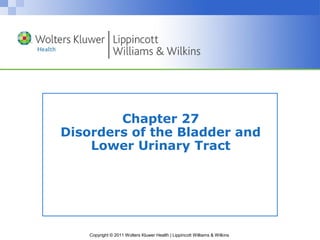More Related Content
Similar to Chapter027 (20)
More from stanbridge (20)
Chapter027
- 1. Chapter 27
Disorders of the Bladder and
Lower Urinary Tract
Copyright © 2011 Wolters Kluwer Health | Lippincott Williams & Wilkins
- 2. Micturition Reflex
• Begins when bladder
contains 150–250 mL
of urine
urine
produced in
kidneys
ureters
bladder fills
with urine
Copyright © 2011 Wolters Kluwer Health | Lippincott Williams & Wilkins
- 3. Stretch Receptors in the Bladder
stretch
receptors
stretch
receptors
bladder fills
with urine
Copyright © 2011 Wolters Kluwer Health | Lippincott Williams & Wilkins
micturition
center in
pons
stimulated
spinal reflex
stimulated
- 4. Copyright © 2011 Wolters Kluwer Health | Lippincott Williams & Wilkins
Urination
• Detrusor muscle of bladder contracts to
push urine out
• Abdominal muscles may also be used
• Internal sphincter relaxes
• External sphincter relaxes
- 7. Copyright © 2011 Wolters Kluwer Health | Lippincott Williams & Wilkins
Question
Tell whether the following statement is true or false:
Abdominal muscles are used during forced urination.
- 8. Copyright © 2011 Wolters Kluwer Health | Lippincott Williams & Wilkins
Answer
True
Passive urination occurs when the bladder’s detrusor
muscle contracts, and both internal and external
sphincter muscles are relaxed. Abdominal muscles
contract in order to force the excretion of urine.
- 9. Parasympathetic Nerves
stretch
receptors
M3 receptors
M3 receptors
bladder fills
with urine
detrusor
muscle
contracts
internal sphincter
relaxes and is pulled
open
spinal reflex
stimulated
parasympathetic
neurons
Copyright © 2011 Wolters Kluwer Health | Lippincott Williams & Wilkins
- 10. Micturition Center Allows Conscious
Control
stretch
receptors
bladder fills
with urine
detrusor
muscle
contracts
internal sphincter
relaxes and is pulled
open
micturition
center in
pons
stimulated
external
sphincter
relaxes
Copyright © 2011 Wolters Kluwer Health | Lippincott Williams & Wilkins
- 11. Copyright © 2011 Wolters Kluwer Health | Lippincott Williams & Wilkins
Question
All but which of the following stimulates urination?
a. Parasympathetic nervous system neurons
b. Micturition center
c. Sympathetic nervous center
d. Spinal reflex
- 12. Copyright © 2011 Wolters Kluwer Health | Lippincott Williams & Wilkins
Answer
c. Sympathetic nervous system
The micturition center in the pons and the spinal reflex
respond to stretch receptors in the bladder to stimulate
urination. The parasympathetic nervous system
neurons are stimulated by the spinal reflex to cause
urination.
SNS (fight-or-flight) decreases activity in both the
excretory and digestive systems.
- 13. Copyright © 2011 Wolters Kluwer Health | Lippincott Williams & Wilkins
Scenario
A 63-year-old woman complains of stress incontinence,
and her 60-year-old husband complains of difficulty
voiding.
Question:
• Why do people of the same age and lifestyle have
opposite problems with urination?
- 14. Male vs. Female Urethra
• Female is urethra 2.5–3.5 cm long
• Allows urine to pass more freely
• Male urethra 16.5–18.5 cm long
• Passes through prostate
Copyright © 2011 Wolters Kluwer Health | Lippincott Williams & Wilkins
- 15. Copyright © 2011 Wolters Kluwer Health | Lippincott Williams & Wilkins
Question
Tell whether the following statement is true or false:
Benign prostatic hypertrophy (BPH) has no effect on the
elimination of urine.
- 16. Copyright © 2011 Wolters Kluwer Health | Lippincott Williams & Wilkins
Answer
False
Because the male urethra passes through the prostate
gland, if the gland increases in size the urethra may
become compressed or obstructed. This decreases the
diameter of the urethra’s lumen, and the ability to
urinate is diminished.
- 17. Copyright © 2011 Wolters Kluwer Health | Lippincott Williams & Wilkins
Scenario
Six months later, the husband develops
urgency and incontinence…
• The doctor explains that it is due to his
muscle strength.
Question:
• Which muscles is the doctor talking about?
• How did they cause incontinence?
- 18. Bladder Wall Hypertrophy
• The bladder may also
pouch outward in
diverticuli
Copyright © 2011 Wolters Kluwer Health | Lippincott Williams & Wilkins
Editor's Notes
- Author: Please add title.
- Author: Please add title.
